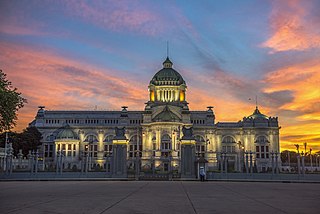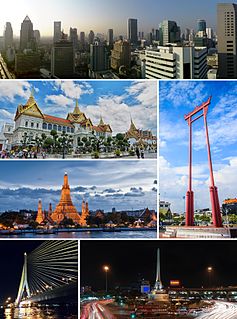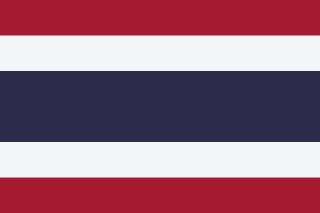
The flag of the Kingdom of Thailand shows five horizontal stripes in the colours red, white, blue, white and red, with the central blue stripe being twice as wide as each of the other four. The design was adopted on 28 September 1917, according to the royal decree issued by Rama VI that year. Since 2016, that day is a national day of importance in Thailand celebrating the nation's flag.

Surin is one of the northeastern provinces (changwat) of Thailand. Neighboring provinces are Buriram, Maha Sarakham, Roi Et, and Sisaket. To the south it borders Oddar Meancheay of Cambodia. Surin covers a total area of 8,124 km2 (3,137 sq mi) from the Mun River in the north to the Dangrek Mountains in the south. The capital, Surin city, in the western central region province is 434 km from Bangkok.

Suphan Buri is one of the central provinces (changwat) of Thailand. Neighbouring provinces are Uthai Thani, Chai Nat, Sing Buri, Ang Thong, Phra Nakhon Si Ayutthaya, Nakhon Pathom and Kanchanaburi.

The National Science Museum is a science museum in Thailand. Located in Khlong Ha, Khlong Luang District, Pathum Thani Province, it was officially opened in 2000 to celebrate Queen Sirikit's 60th birthday. The museum operates under the Ministry of Science and Technology.

Siem Reap is the capital city of Siem Reap Province in northwestern Cambodia. It is a popular resort town and a gateway to the Angkor region.

The Samutprakarn Crocodile Farm and Zoo is a crocodile zoo in Samut Prakan Province, Thailand. The park claims to hold the world's largest crocodile in captivity, named Yai, measuring 6 m and weighing 1,114 kg (2,456 lb). Yai is one among over 100,000 crocodiles at the farm.
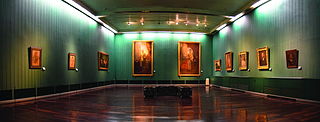
The National Gallery is an art gallery and one of Thailand's national museums. It is located on Chao Fa Road in Bangkok's historic Phra Nakhon District, and is housed in the building of the former Royal Thai Mint. The gallery's collections range from traditional Thai art to the Western-influenced portraiture of the 19th century and modern and contemporary works.

The Bangkok National Museum is the main branch museum of the National Museums in Thailand and also one of the largest museum in Southeast Asia. It features exhibits of Thai art and history. The museum is located in 4 Na Phra That, Bangkok 10200, Thailand, occupying the former palace of the vice king, set between Thammasat University, and the National Theater, facing Sanam Luang.

Erawan Museum is a museum in Samut Prakan Province, Thailand. It is well known for its giant three-headed elephant art display. The three storeys inside the elephant contain antiquities and priceless collections of ancient religious objects belonging to Khun Lek Viriyapant who is the museum owner.

The Jim Thompson House is a museum in central Bangkok, Thailand, housing the art collection of American businessman and architect Jim Thompson, the museum designer and former owner. Built in 1959, the museum spans one rectangular "rai" of land. It is one of the most popular tourist destinations in Thailand; sporting vibrant jungle foliage in the heart of the city.

The Kamthieng House Museum is a museum in Watthana District, Bangkok, run by the Siam Society under royal patronage. It is a 160-year-old traditional teakwood house from northern Thailand.

King Prajadhipok Museum is a museum in Pom Prap Sattru Phai District, Bangkok, Thailand.
Bank of Thailand Museum is a museum in Bangkok, Thailand. The museum is housed in the Bang Khun Phrom Palace, the former residence of Prince Paribatra Sukhumbandhu, who was the 33rd son of King Chulalongkorn. The Bank of Thailand, Northern Region also has a museum in Chiang Mai.

The National Museum of Royal Barges is a museum in Bangkok, Thailand. It is on the northern rim of Bangkok Noi canal in the Bangkok Noi District.
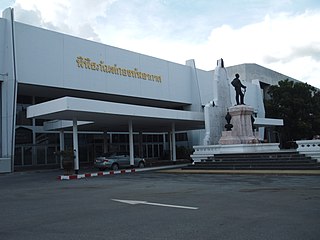
The Royal Thai Air Force Museum is located in Don Mueang District, Bangkok, Thailand. It is located on the Phahonyothin road just to the south of Wing 6 of the domestic terminal of the Don Mueang Airport.
Silapakorn University Art Gallery is an art gallery and museum in Bangkok, Thailand. It is a building in Silpakorn University Wang Tha Phra Campus on Na Pralarn Road, directly north of the Grand Palace and south of Wat Mahathat Yuwaratrangsarit. It was created in 1994.
On 26 May 1998, the Thai government declared the 13th of March to annually be the Thai National Elephant Day or Chang Thai Day. The observance was suggested by the Asian Elephant Foundation of Thailand and submitted to the Coordinating Subcommittee for the Conservation of Thai Elephants. The date was chosen because the Royal Forest Department designated the white elephant as the national animal of Thailand on 13 March 1963.
The elephant has been a contributor to Thai society and its icon for many centuries. The elephant has had a considerable impact on Thai culture. The Thai elephant is the official national animal of Thailand. The elephant found in Thailand is the Indian elephant, a subspecies of the Asian elephant. In the early-1900s there were an estimated 100,000 domesticated or captive elephants in Thailand. In mid-2007 there were an estimated 3,456 domesticated elephants left in Thailand and roughly a thousand wild elephants. It became an endangered species in 1986.

Samphran Elephant Ground & Zoo is a famous tourist places suitable for all ages and located in Tha Kham, Sam Phran, Nakhon Pathom Province, central Thailand.

Tha Chang Pier, or well known in Thai Tha Chang Wang Luang, with designated pier code N9 is pier on Chao Phraya River located on the end of Na Phra Lan Road in the area behind Grand Palace next to Nagaraphirom Park and Ratchaworadit Pier.

